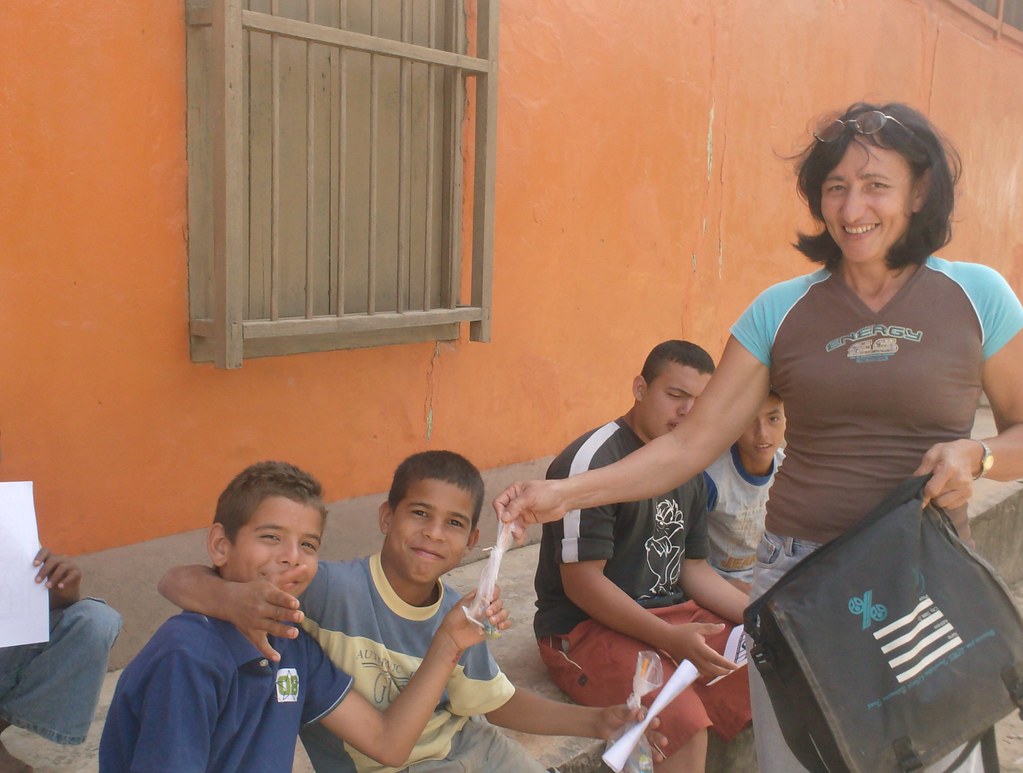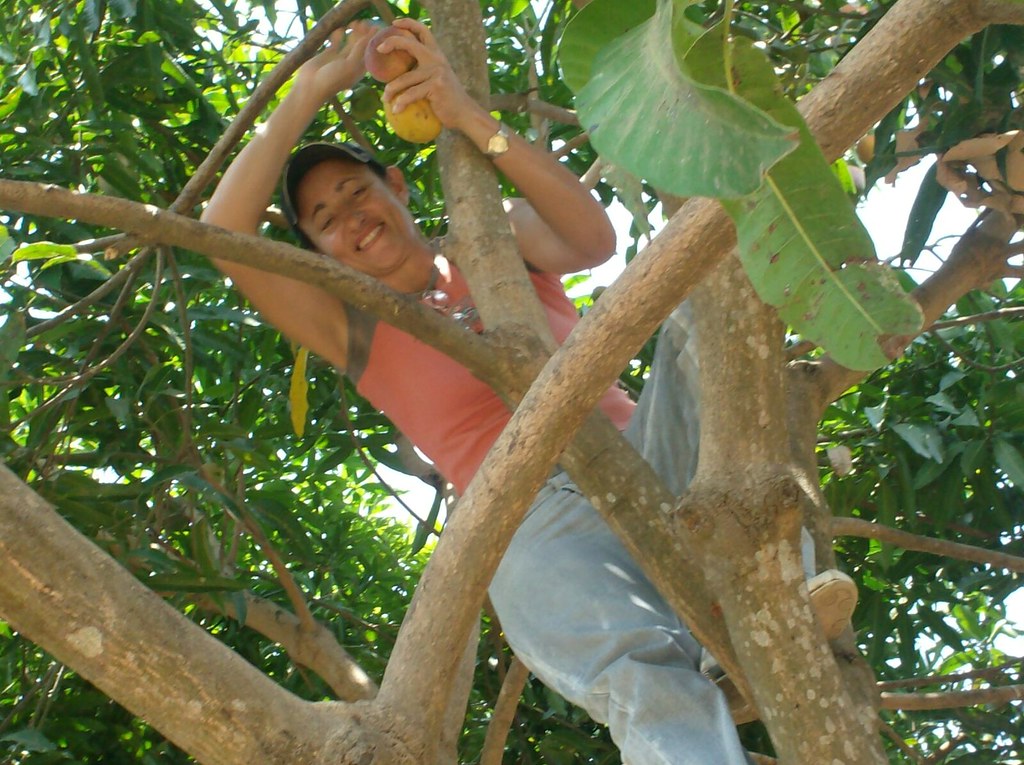 On Tuesday of Holy Week, Luz María left with her daughters, Charli and Sarai; grandson, Edwar José; son-in-law, José Garrida; and 11-year-old Sandro Pérez on a missionary journey to the neighboring state of Apure. As far as we know, it was the first time anyone has visited Apure on behalf of the Lutheran Church of Venezuela. I would have loved to have gone with them, but Eduardo and I were committed to leading Maundy Thursday and Good Friday services at Corpus Christi Lutheran Church in Barinas.
On Tuesday of Holy Week, Luz María left with her daughters, Charli and Sarai; grandson, Edwar José; son-in-law, José Garrida; and 11-year-old Sandro Pérez on a missionary journey to the neighboring state of Apure. As far as we know, it was the first time anyone has visited Apure on behalf of the Lutheran Church of Venezuela. I would have loved to have gone with them, but Eduardo and I were committed to leading Maundy Thursday and Good Friday services at Corpus Christi Lutheran Church in Barinas.
We had been invited by the large, extended family to which José and Sandro both belong (they are cousins). Since nearly everyone in Venezuela enjoys a whole week of vacation during Holy Week, they thought it was a good time to have us lead a vacation Bible school for children in Palmarito, Apure.
 Sandro lives with his family just across the street from us in La Caramuca. He has attended our Sunday school regularly for a long time and now is one of the students in our confirmation class. This year he is one of the recipients of scholarships from Children's Christian Concern Society of Topeka, Kansas. This trip was a great opportunity for Sandro to meet his grandparents and many aunts and uncles in Palmarito that he had never seen before.
Sandro lives with his family just across the street from us in La Caramuca. He has attended our Sunday school regularly for a long time and now is one of the students in our confirmation class. This year he is one of the recipients of scholarships from Children's Christian Concern Society of Topeka, Kansas. This trip was a great opportunity for Sandro to meet his grandparents and many aunts and uncles in Palmarito that he had never seen before.
Apure is one of the 23 states that constitute the republic of Venezuela. It lies southwest of our state, Barinas, and is also bounded on the north by the states of Táchira and Guárico. To the southeast of Apure lie the Venezuelan states of Bolívar and Amazonas and to the south and west, the nation of Colombia. Together with the states of Barinas, Portuguesa, Guárico, Anzoátegui y Monagas, Apure is part of a region known as los Llanos, which is Spanish for “the Plains”. This is a broad grasslands region which stretches across the center of Ve
 nezuela, north of the Orinoco River but south of the mountains which stretch along most of Venezuela's northern tier and just to the west of the vast Orinoco delta. Los Llanos are home to many Texas-style cattle ranches and, in fact, there is a “cowboy mystique” about the region similar to that of Texas and the southwestern United States.
nezuela, north of the Orinoco River but south of the mountains which stretch along most of Venezuela's northern tier and just to the west of the vast Orinoco delta. Los Llanos are home to many Texas-style cattle ranches and, in fact, there is a “cowboy mystique” about the region similar to that of Texas and the southwestern United States. Apure is the setting of Doña Barbara, Rómulo Gallegos' epic novel about Venezuelan ranch life, which is the Venezuelan national novel. Two feature film adaptations of Doña Barbara have been made, one in 1943 and the other in 1998. A television miniseries was broadcast in 1975. To understand current Venezuelan politics, you must understand the literary allusions to Doña Barbara and Alberto Arvelo Torrealba's epic poem, “Florentino y el diablo” (which also is set in los Llanos).
Our group gathered at 6 a.m. to take a bus to Pedraza, which bills itself as the “river capital of Venezuela” as it is a center for whitewater rafting expeditions. They traveled west to go east, but it was really the most direct route to Palmarito.
 It was an hour's ride to Pedraza, and then three and half hours in a rented van to the banks of the Apure River where the town of Palmarito is located. A tributary of the Orinoco, the second-largest river in South America, the Apure is a large body of water in its own right. The van had to be ferried across the river to reach Palmarito and later our group made several visits to peoples' homes by canoe. However, unlike in the novel, Doña Barbara, nobody had to shoot any alligators.
It was an hour's ride to Pedraza, and then three and half hours in a rented van to the banks of the Apure River where the town of Palmarito is located. A tributary of the Orinoco, the second-largest river in South America, the Apure is a large body of water in its own right. The van had to be ferried across the river to reach Palmarito and later our group made several visits to peoples' homes by canoe. However, unlike in the novel, Doña Barbara, nobody had to shoot any alligators.
Luz María thinks Palmarito is a larger town than La Caramuca, but it is much more isolated from the outside world. During the last half of the 20th Century, Venezuela was transformed from a predominantly rural nation into an urban one, much like the United States. However, although the population of Venezuela's urban areas exploded as people moved from the country to the cities, the overall birth rate remained high enough that rural populations did not diminish as in the United States, but remained stable. But as economic resources have been diverted to urban areas to deal with the massive influx of people, the backwoods of Venezuela have been left more backwoodsy than ever.
 There is a fairly large Roman Catholic church building in Palmarito, but there has been no priest in residence for many years. A priest shows up about once a year to celebrate Mass, but has no other involvement with the community. This is typical of rural Venezuela as there is a critical shortage of priests to serve the more isolated areas. Three nuns live in the church to maintain it and organize a variety of activities for children and young people. While our group was there, the nuns organized a traditional procession of the Cross, with the help mostly of young people. There are very few adults that are in any way active in the Catholic church, other than possibly attending the once-a-year Mass. Many people in the community, however, are involved in the practice of brujería or witchcraft. The prevalence of brujería in los Llanos also is one of the themes of Doña Barbara.
There is a fairly large Roman Catholic church building in Palmarito, but there has been no priest in residence for many years. A priest shows up about once a year to celebrate Mass, but has no other involvement with the community. This is typical of rural Venezuela as there is a critical shortage of priests to serve the more isolated areas. Three nuns live in the church to maintain it and organize a variety of activities for children and young people. While our group was there, the nuns organized a traditional procession of the Cross, with the help mostly of young people. There are very few adults that are in any way active in the Catholic church, other than possibly attending the once-a-year Mass. Many people in the community, however, are involved in the practice of brujería or witchcraft. The prevalence of brujería in los Llanos also is one of the themes of Doña Barbara.
The nuns also teach classes in cooking, sewing and computation. There is an elementary school in Palmarito, but no opportunities for education beyond that level anywhere near the town. Anyone who wants to learn skills that would enable them to be other than simple manual laborers must leave Palmarito. Of course, most of those who do will not return to provide the community with the benefit of their education. There is great poverty in the area. Many of the children and even some teenagers have never owned a pair of shoes. There are people who work for nothing but to have food and clothes on their backs.
 For this reason, our group brought gifts of clothing donated by the Corpus Christi congregation and by interested persons in La Caramuca. For the vacation Bible school, Luz María made use of many of the teaching materials that have been provided for us by our supporting churches in the United States.
For this reason, our group brought gifts of clothing donated by the Corpus Christi congregation and by interested persons in La Caramuca. For the vacation Bible school, Luz María made use of many of the teaching materials that have been provided for us by our supporting churches in the United States.
The theme of the vacation Bible school was the connection between the Genesis account of the creation and fall of man, and the events of Holy Week. Many of the children had never made this connection before and they had many questions. There were 42 in attendance Wednesday, the first day of the vacation Bible school. The second day there were 29 and the fourth day there were 40.

 It was a great adventure for Luz María because, although she was born in the neighboring state of Guárico, she had never been to Apure before. She bought herself an inexpensive digital camera and took over 200 pictures throughout the trip. Thanks be to God, everyone returned to Barinas safe and sound on the Saturday before Easter Sunday.
It was a great adventure for Luz María because, although she was born in the neighboring state of Guárico, she had never been to Apure before. She bought herself an inexpensive digital camera and took over 200 pictures throughout the trip. Thanks be to God, everyone returned to Barinas safe and sound on the Saturday before Easter Sunday.
Meanwhile, we had good attendance for all our Holy Week services at Corpus Christi. I preached the Palm Sunday and Maundy Thursday sermons, while Eduardo preached on Easter Sunday. On Good Friday we alternated between reading and offering brief meditations on each of the seven last words of Christ from the cross.
No comments:
Post a Comment